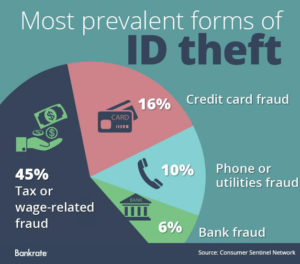 The National Consumer Law Center (NCLC) recently published a report on debt collections and complaints surrounding those collection actions for 2018. This report includes an online interactive map, which can be searched by state, showing the statistics on the percentage of the state residents in collections, along with the top complaint types against debt collectors. Honestly, it’s an ugly state of affairs. And if you, my reader, are currently in collections, you may want to take a look at the information for your state. I promise, you are NOT alone in the frustration and fear surrounding collections, particularly when bad actors break the law. The top three complaints reported by the NCLC?
The National Consumer Law Center (NCLC) recently published a report on debt collections and complaints surrounding those collection actions for 2018. This report includes an online interactive map, which can be searched by state, showing the statistics on the percentage of the state residents in collections, along with the top complaint types against debt collectors. Honestly, it’s an ugly state of affairs. And if you, my reader, are currently in collections, you may want to take a look at the information for your state. I promise, you are NOT alone in the frustration and fear surrounding collections, particularly when bad actors break the law. The top three complaints reported by the NCLC?
> “Calls After Getting ‘Stop Calling’ Notice” (227,917 complaints),
> “Calls Repeatedly” (210,238 complaints),
> “Makes False Representation about Debt” (192,704 complaints),
I also promise you, dear reader, these numbers are way underreported. A vast number of consumers won’t complain. Won’t assert their rights. And collectors know this, which is why they continue to violate federal law. The Urban Institute reported in July 2018 that 71 million American adults had at least one account in collections. 71 million Americans in collections, yet under one million complaints against collection agencies who violate the law.
There is a very honorable, yet misguided reason, many people won’t report harassment from collectors. Because they owe the money. But do they really? One of the biggest complaints is that consumers are harassed about debts that don’t owe, or that are time-barred form a lawsuit when the statute of limitations runs out. That’s right. The debt can become too old for a lawsuit. Still on the consumer’s report? Sure. Consumer still technically owes the money? Sure. But the consumer cannot be sued in court.
This is a huge distinction under the law and there is one mistake many consumers make. The statute of limitations will be restated if any payment is made on the account, no matter how small. Let me reiterate that very important point: Collectors will harass, call, and threaten a consumer for just, “any payment at all” because if the consumer gives them even a dollar on a debt that is too old to sue on, THE CONSUMER WILL RESTART THE STATUTE OF LIMITATIONS.
And they won’t warn the consumer that the debt they are calling on is too old, sometimes called a “zombie” debt. Why? Because it is part of their business model. They aren’t obligated by the law to tell the debtor. They will call and ask the consumer to settle. If the consumer makes ANY payment or promise, and revives they statute of limitations, the consumer is again are at risk for a lawsuit. Even if the debt was only days from being time-barred. So they do it. Call on very, very old debt. And they will harass the consumer to try to get them to settle again, or start to threaten with a lawsuit. And make no mistake, threatening a lawsuit when they do not intend to follow through is a violation of the law. Credit.com has an interactive map with the statute of limitations for each state. It’s possible that the collector may, however, still report a time-barred debt to the credit bureaus. Unless the debt is too old for the collector to do that either. And they won’t tell the consumer that tidbit either when they call.
But, there is some good news, and some maybe not good news on the horizon for 2019. First, the good news. Many states have debt collection laws that are stronger than the Federal Debt Collection Practices Act. Ans some states are taking aggressive action to force collectors to tell consumers when the debts are too old. California, for example, recently enacted legislation that require collectors to place specific notices on communications to ensure consumers know when the collector is trying to collect a time-barred debt, including an additional notification if the debt is so old it can no longer be reported to the credit bureaus under the Fair Credit Reporting Act. Many states have an “Unfair Practices Act” type set of laws as well that have protections for consumers, these vary by state.
Now, for the maybe good news. On the national level, The Consumer Financial Protection Bureau is expected to take steps this March and release some changes to the rules around debt collection practices on the federal level. Consumer advocates are pushing for those changes to include a rule requiring Collectors give written notification to consumers when a debt is too old for a law suit or too old to be reported on the consumer’s credit report. I’ll let you know what comes out. For now, there are a few things to remember to do if you are in this situation:
1. Check your state statute of limitation for consumer debt before making ANY payment, no matter how small, to a collector.
2. If you are being harassed, or a collector is trying to get a payment on a debt you do not owe, contact a consumer advocacy agency or attorney and find out the federal and state laws available to protect you.

 Credit: nlipw.com
Credit: nlipw.com photo:credit.org
photo:credit.org
 To make matters worse, in my humble opinion, the guardians of your credit report (and mysteriously calculated “score”) actually charge consumers hard earned dollars for access to their OWN information. The nerve! But my feelings aside, checking your credit report is an important part of taking control of your money. The Fair Credit Reporting Act, FCRA, authorizes one free credit report each year from each of the three credit reporting bureaus. There is only one link that is “federally certified” so do not click into any of the 34 ads on the way to
To make matters worse, in my humble opinion, the guardians of your credit report (and mysteriously calculated “score”) actually charge consumers hard earned dollars for access to their OWN information. The nerve! But my feelings aside, checking your credit report is an important part of taking control of your money. The Fair Credit Reporting Act, FCRA, authorizes one free credit report each year from each of the three credit reporting bureaus. There is only one link that is “federally certified” so do not click into any of the 34 ads on the way to  The Debt Management Service
The Debt Management Service


